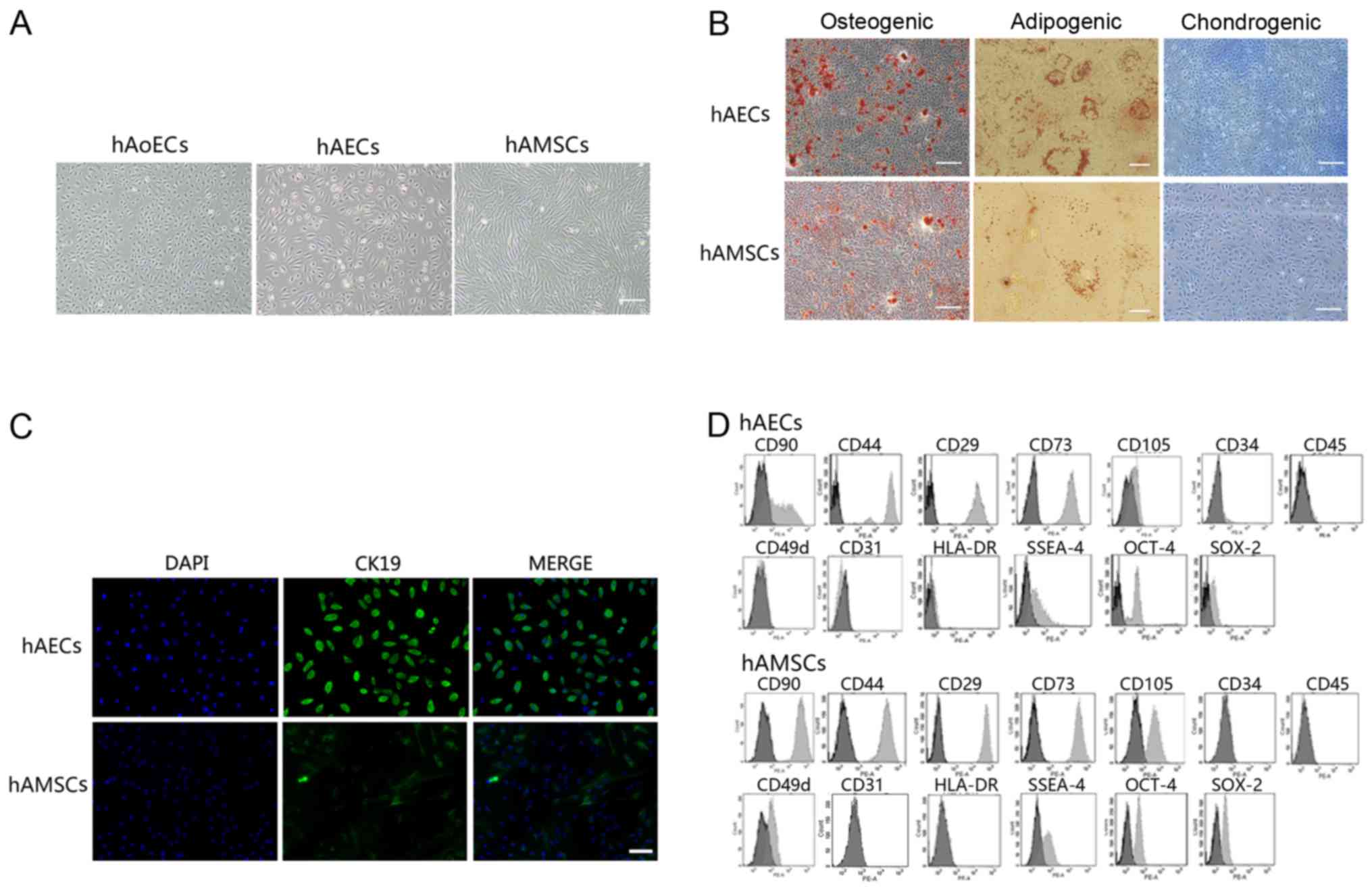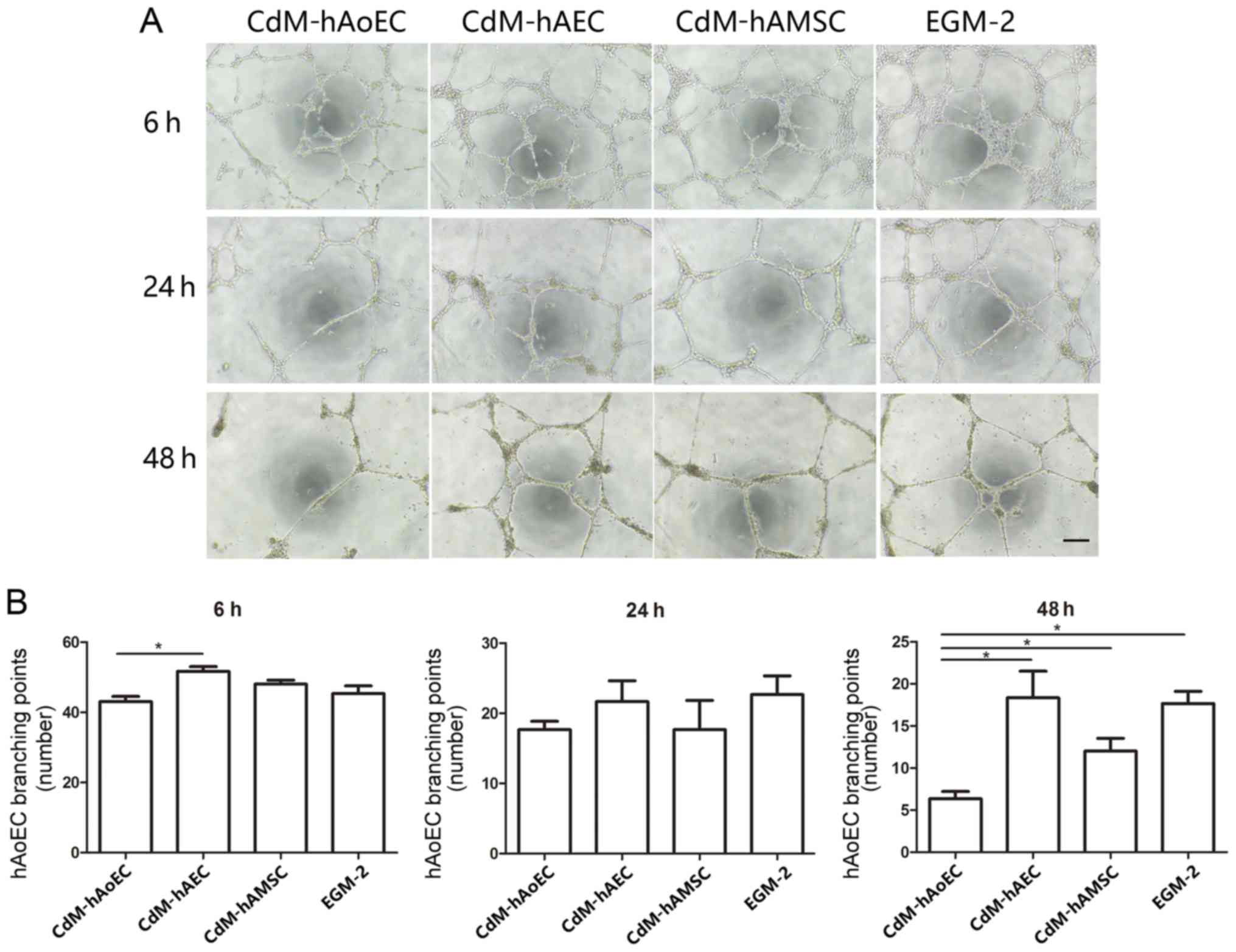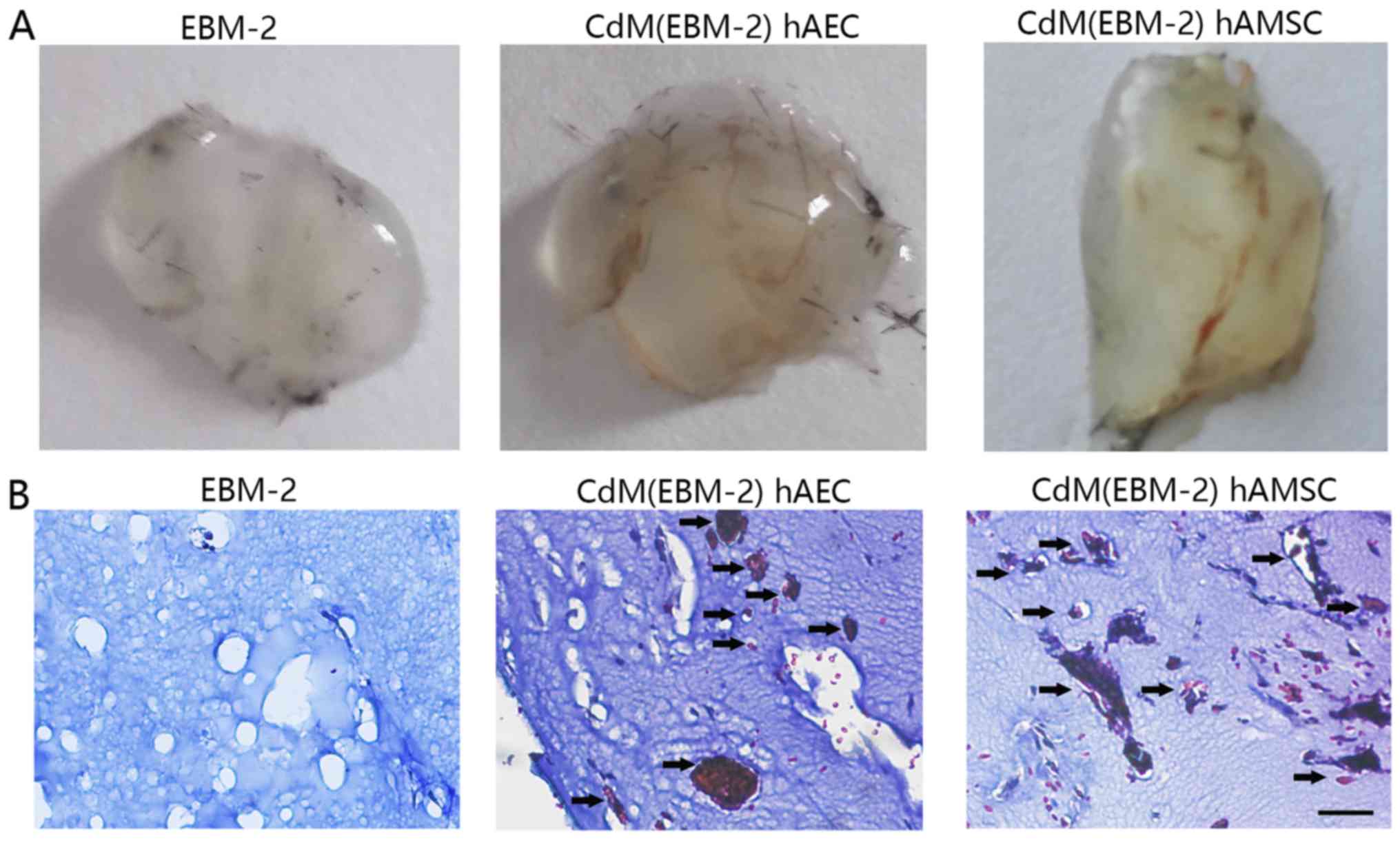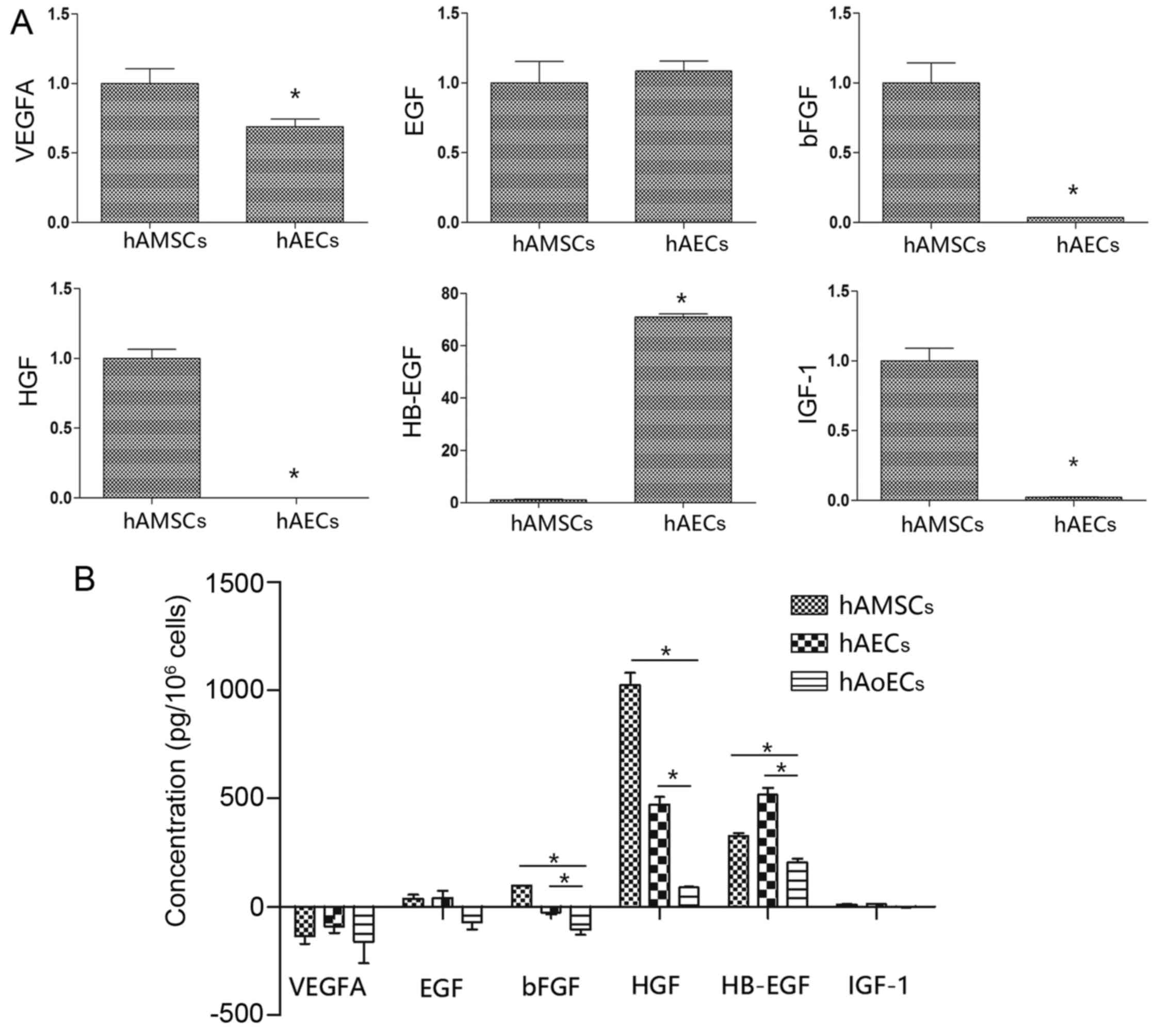|
1
|
Ilancheran S, Michalska A, Peh G, Wallace
EM, Pera M and Manuelpillai U: Stem cells derived from human fetal
membranes display multilineage differentiation potential. Biol
Reprod. 77:577–588. 2007. View Article : Google Scholar : PubMed/NCBI
|
|
2
|
Kim SW, Zhang HZ, Kim CE, An HS, Kim JM
and Kim MH: Amniotic mesenchymal stem cells have robust angiogenic
properties and are effective in treating hindlimb ischaemia.
Cardiovasc Res. 93:525–534. 2012. View Article : Google Scholar
|
|
3
|
Kinnaird T, Stabile E, Burnett MS, Lee CW,
Barr S, Fuchs S and Epstein SE: Marrow-derived stromal cells
express genes encoding a broad spectrum of arteriogenic cytokines
and promote in vitro and in vivo arteriogenesis through paracrine
mechanisms. Circ Res. 94:678–685. 2004. View Article : Google Scholar : PubMed/NCBI
|
|
4
|
Yoshida Y, Tanaka S, Umemori H, Minowa O,
Usui M, Ikematsu N, Hosoda E, Imamura T, Kuno J, Yamashita T, et
al: Negative regulation of BMP/Smad signaling by Tob in
osteoblasts. Cell. 103:1085–1097. 2000. View Article : Google Scholar
|
|
5
|
Liu X, Wang Z, Wang R, Zhao F, Shi P,
Jiang Y and Pang X: Direct comparison of the potency of human
mesenchymal stem cells derived from amnion tissue, bone marrow and
adipose tissue at inducing dermal fibroblast responses to cutaneous
wounds. Int J Mol Med. 31:407–415. 2013.
|
|
6
|
Fidelis-de-Oliveira P, Werneck-de-Castro
JPS, Pinho-Ribeiro V, Shalom BC, Nascimento-Silva JH, Costa e Souza
RH, Cruz IS, Rangel RR, Goldenberg RC and Campos-de-Carvalho AC:
Soluble factors from multipotent mesenchymal stromal cells have
antinecrotic effect on cardiomyocytes in vitro and improve cardiac
function in infarcted rat hearts. Cell Transplant. 21:1011–1021.
2012. View Article : Google Scholar : PubMed/NCBI
|
|
7
|
Timmers L, Lim SK, Hoefer IE, Arslan F,
Lai RC, van Oorschot AA, Goumans MJ, Strijder C, Sze SK, Choo A, et
al: Human mesenchymal stem cell-conditioned medium improves cardiac
function following myocardial infarction. Stem Cell Res (Amst).
6:206–214. 2011. View Article : Google Scholar
|
|
8
|
Balsam LB, Wagers AJ, Christensen JL,
Kofidis T, Weissman IL and Robbins RC: Haematopoietic stem cells
adopt mature haematopoietic fates in ischaemic myocardium. Nature.
428:668–673. 2004. View Article : Google Scholar : PubMed/NCBI
|
|
9
|
Nygren JM, Jovinge S, Breitbach M, Säwén
P, Röll W, Hescheler J, Taneera J, Fleischmann BK and Jacobsen SE:
Bone marrow-derived hematopoietic cells generate cardiomyocytes at
a low frequency through cell fusion, but not transdifferentiation.
Nat Med. 10:494–501. 2004. View
Article : Google Scholar : PubMed/NCBI
|
|
10
|
Kinnaird T, Stabile E, Burnett MS, Shou M,
Lee CW, Barr S, Fuchs S and Epstein SE: Local delivery of
marrow-derived stromal cells augments collateral perfusion through
paracrine mechanisms. Circulation. 109:1543–1549. 2004. View Article : Google Scholar : PubMed/NCBI
|
|
11
|
Konala VBR, Mamidi MK, Bhonde R, Das AK,
Pochampally R and Pal R: The current landscape of the mesenchymal
stromal cell secretome: A new paradigm for cell-free regeneration.
Cytotherapy. 18:13–24. 2016. View Article : Google Scholar :
|
|
12
|
Yamaguchi S, Shibata R, Yamamoto N,
Nishikawa M, Hibi H, Tanigawa T, Ueda M, Murohara T and Yamamoto A:
Dental pulp-derived stem cell conditioned medium reduces cardiac
injury following ischemia-reperfusion. Sci Rep. 5:162952015.
View Article : Google Scholar : PubMed/NCBI
|
|
13
|
König J, Huppertz B, Desoye G, Parolini O,
Fröhlich JD, Weiss G, Dohr G, Sedlmayr P and Lang I: Amnion-derived
mesenchymal stromal cells show angiogenic properties but resist
differentiation into mature endothelial cells. Stem Cells Dev.
21:1309–1320. 2012. View Article : Google Scholar
|
|
14
|
Sha X, Liu Z, Song L, Wang Z and Liang X:
Human amniotic epithelial cell niche enhances the functional
properties of human corneal endothelial cells via inhibiting P53
-survivin-mitochondria axis. Exp Eye Res. 116:36–46. 2013.
View Article : Google Scholar : PubMed/NCBI
|
|
15
|
König J, Weiss G, Rossi D, Wankhammer K,
Reinisch A, Kinzer M, Huppertz B, Pfeiffer D, Parolini O and Lang
I: Placental mesenchymal stromal cells derived from blood vessels
or avascular tissues: What is the better choice to support
endothelial cell function? Stem Cells Dev. 24:115–131. 2015.
View Article : Google Scholar :
|
|
16
|
Yamahara K, Harada K, Ohshima M, Ishikane
S, Ohnishi S, Tsuda H, Otani K, Taguchi A, Soma T, Ogawa H, et al:
Comparison of angiogenic, cytoprotective, and immunosuppressive
properties of human amnion- and chorion-derived mesenchymal stem
cells. PLoS One. 9:e883192014. View Article : Google Scholar : PubMed/NCBI
|
|
17
|
Yotsumoto F, Tokunaga E, Oki E, Maehara Y,
Yamada H, Nakajima K, Nam SO, Miyata K, Koyanagi M, Doi K, et al:
Molecular hierarchy of heparin-binding EGF-like growth
factor-regulated angiogenesis in triple-negative breast cancer. Mol
Cancer Res. 11:506–517. 2013. View Article : Google Scholar : PubMed/NCBI
|
|
18
|
Kim SW, Zhang HZ, Guo L, Kim JM and Kim
MH: Amniotic mesenchymal stem cells enhance wound healing in
diabetic NOD/SCID mice through high angiogenic and engraftment
capabilities. PLoS One. 7:e411052012. View Article : Google Scholar : PubMed/NCBI
|
|
19
|
Miki T, Lehmann T, Cai H, Stolz DB and
Strom SC: Stem cell characteristics of amniotic epithelial cells.
Stem Cells. 23:1549–1559. 2005. View Article : Google Scholar : PubMed/NCBI
|
|
20
|
Parolini O, Alviano F, Bagnara GP, Bilic
G, Bühring HJ, Evangelista M, Hennerbichler S, Liu B, Magatti M,
Mao N, et al: Concise review: Isolation and characterization of
cells from human term placenta: Outcome of the first international
Workshop on Placenta Derived Stem Cells. Stem Cells. 26:300–311.
2008. View Article : Google Scholar
|
|
21
|
Grzywocz Z, Pius-Sadowska E, Klos P,
Gryzik M, Wasilewska D, Aleksandrowicz B, Dworczynska M, Sabalinska
S, Hoser G, Machalinski B, et al: Growth factors and their
receptors derived from human amniotic cells in vitro. Folia
Histochem Cytobiol. 52:163–170. 2014. View Article : Google Scholar : PubMed/NCBI
|
|
22
|
Alviano F, Fossati V, Marchionni C,
Arpinati M, Bonsi L, Franchina M, Lanzoni G, Cantoni S, Cavallini
C, Bianchi F, et al: Term Amniotic membrane is a high throughput
source for multipotent Mesenchymal Stem Cells with the ability to
differentiate into endothelial cells in vitro. BMC Dev Biol.
7:112007. View Article : Google Scholar : PubMed/NCBI
|
|
23
|
Manochantr S, U-pratya Y, Kheolamai P,
Rojphisan S, Chayosumrit M, Tantrawatpan C, Supokawej A and
Issaragrisil S: Immunosuppressive properties of mesenchymal stromal
cells derived from amnion, placenta, Wharton's jelly and umbilical
cord. Intern Med J. 43:430–439. 2013. View Article : Google Scholar
|
|
24
|
Magatti M, De Munari S, Vertua E, Gibelli
L, Wengler GS and Parolini O: Human amnion mesenchyme harbors cells
with allogeneic T-cell suppression and stimulation capabilities.
Stem Cells. 26:182–192. 2008. View Article : Google Scholar
|
|
25
|
Magatti M, De Munari S, Vertua E, Nassauto
C, Albertini A, Wengler GS and Parolini O: Amniotic mesenchymal
tissue cells inhibit dendritic cell differentiation of peripheral
blood and amnion resident monocytes. Cell Transplant. 18:899–914.
2009. View Article : Google Scholar : PubMed/NCBI
|
|
26
|
Fatimah SS, Tan GC, Chua K, Fariha MMN,
Tan AE and Hayati AR: Stemness and angiogenic gene expression
changes of serial-passage human amnion mesenchymal cells. Microvasc
Res. 86:21–29. 2013. View Article : Google Scholar
|
|
27
|
Gnecchi M, He H, Liang OD, Melo LG,
Morello F, Mu H, Noiseux N, Zhang L, Pratt RE, Ingwall JS, et al:
Paracrine action accounts for marked protection of ischemic heart
by Akt-modified mesenchymal stem cells. Nat Med. 11:367–368. 2005.
View Article : Google Scholar : PubMed/NCBI
|
|
28
|
Caplan AI and Dennis JE: Mesenchymal stem
cells as trophic mediators. J Cell Biochem. 98:1076–1084. 2006.
View Article : Google Scholar : PubMed/NCBI
|
|
29
|
Yamakawa H, Muraoka N, Miyamoto K,
Sadahiro T, Isomi M, Haginiwa S, Kojima H, Umei T, Akiyama M,
Kuishi Y, et al: Fibroblast growth factors and vascular endothelial
growth factor promote cardiac reprogramming under defined
conditions. Stem Cell Reports. 5:1128–1142. 2015. View Article : Google Scholar : PubMed/NCBI
|
|
30
|
Chen QH, Liu AR, Qiu HB and Yang Y:
Interaction between mesenchymal stem cells and endothelial cells
restores endothelial permeability via paracrine hepatocyte growth
factor in vitro. Stem Cell Res Ther. 6:442015. View Article : Google Scholar : PubMed/NCBI
|
|
31
|
Barrientos S, Stojadinovic O, Golinko MS,
Brem H and Tomic-Canic M: Growth factors and cytokines in wound
healing. Wound Repair Regen. 16:585–601. 2008. View Article : Google Scholar
|
|
32
|
Chen L, Tredget EE, Wu PY and Wu Y:
Paracrine factors of mesenchymal stem cells recruit macrophages and
endothelial lineage cells and enhance wound healing. PLoS One.
3:e18862008. View Article : Google Scholar : PubMed/NCBI
|
|
33
|
Yang Y, Chen QH, Liu AR, Xu XP, Han JB and
Qiu HB: Synergism of MSC-secreted HGF and VEGF in stabilising
endothelial barrier function upon lipopolysaccharide stimulation
via the Rac1 pathway. Stem Cell Res Ther. 6:2502015. View Article : Google Scholar : PubMed/NCBI
|















